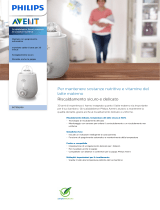
Using the bottle warmer to warm baby food
1 Follow the same steps as indicated in the previous
paragraph.
2 Make sure to stir the baby food during warming as it
does not circulate automatically. Be careful not to burn
your ngers when holding the container/jar while stirring
(Fig. 11).
After warming test the baby food with a spoon to ensure it is
not too hot. If the baby food is not warm enough, put the
container back into the bottle warmer and warm the baby food
until it has the desired temperature.
Note: Due to the high variety of baby food consistencies, it
is strongly recommended to continuously stir and check
while you are warming the baby food for an optimal result.
Note: Due to the high variety of baby food consistencies, it
is not possible to indicate warming timings for baby food.
Using the keep warm setting to warm milk
1 Put the mains plug in the wall socket (Fig. 3).
2 Place the bottle or container in the bottle warmer (Fig. 4).
3 Fill the bottle warmer with drinking water up to the
level of the milk in the bottle/container. In case of
large amounts of milk, the maximum level of water is
approximately 1 cm below the top of the bottle warmer
(Fig. 5).
4 Select the position of keep warm (Fig. 6).
At this setting, you can warm your milk at a slow pace and
keep it warm at the right end temperature. E.g. to warm a
bottle of 4oz milk starting from room temperature, it will
take 15-20min. The warming time may be longer or shorter
depends on the milk volumes and starting temperature.
Note: Philips Avent recommends to feed your baby as
soon as possible after the milk is warmed. We advise not to
reheat the milk after it has cooled down again.
ENGLISH 13
























